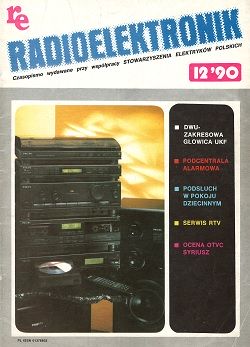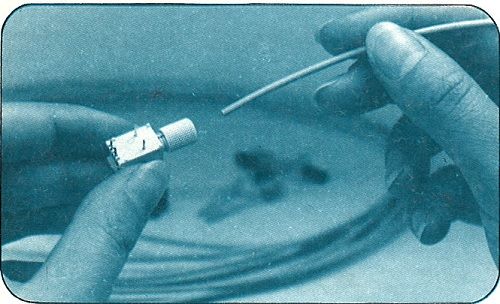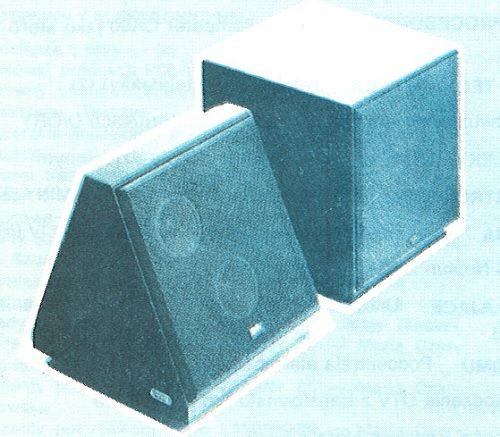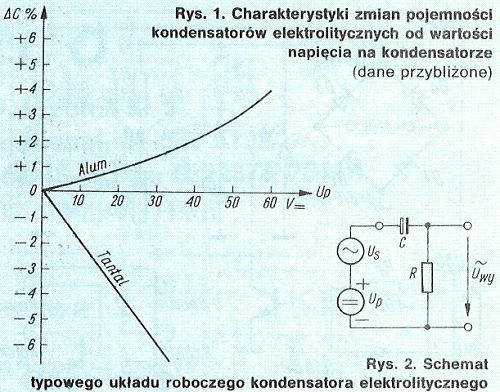
Radioelectronics, December 1990, volume XLI (139)
FROM THE COUNTRY AND FROM THE WORLD (cover page 2)
- PHILIPS FSB260 and FSB290 hi-fi sets.
These new, uniform-looking audio sets (photo shown on cover) are intended for a wide range of middle-income buyers. Both types of sets are equipped with remote control systems, have identical turntables and CDs, but some differences exist in other parts of the sets. - Handy, amateur mixer - tape recorder.
The Japanese company Fostex offers a new mixer - X-15-II cassette deck. The device has external dimensions of 75 x 290 x 195 mm (with a plug-in battery: 75 x 290 x 195 mm) and a weight of 2.9 kg (with battery). A standard C-60 or C-90 cassette is used to make a 4-track recording from the four inputs of the device. - The easiest installation of optical fibers.
Early in the development of fiber optics, installing fiber optics was something of a "higher school of gas cooking" - potentially simple, but required special tools and staff preparation. Today, when installing fiber optics in the home and in the car, it had to be kept to a minimum. This is the purpose of the twisted fiber optic connector.

- Telephones for the cellular network.
The cellular telephone network in developed countries has been a reality for several years, there is also hope that as a result of giving up the state monopoly, it will appear in our country, at least in the largest urban agglomerations. - Cooperation in microprocessors.
Two European "greats" - Siemens and SGS-Thomson - cooperate in the development, production and sale of 8 and 16 - bit microprocessors. The family of 16-bit microprocessors developed by Siemens is already beginning to appear on the market (the first commercial chip is the 80C116) and, as it turned out, it surpasses everything that was previously available in this class of chips..
ANNOUNCEMENTS (1)
ELECTROACOUSTICS - "Duetto-Stereolith" SPEAKER SYSTEM (2)
The company REVOX, known for its high quality products, offers a stereo loudspeaker system operating in accordance with a new concept. As it is easy to reproduce and gives interesting sound effects, it is worth getting to know it better.
The classic way of stereo reproduction requires the use of two loudspeakers separated by a distance, the so-called base. The optimal stereo listening position is in front of the loudspeakers, symmetrically to them. It has long been noticed that when using loudspeakers with a wide angle of sound or omnidirectional radiating units, the position of the listener in relation to the loudspeakers is less critical, but the stereo image of the sound becomes less accurate, especially in terms of the location of the apparent sound sources.

The Swiss acoustician - Walter Schupbach - proposed a solution consisting in placing the speakers of both channels in one housing in such a way that they radiate in opposite directions, i.e. to the left and to the right of the listener. It turned out that the best results are achieved by a housing with a triangular cross-section (see the drawing), divided by a wall into two parts. This solution can be compared to the radiation of sounds by one source, in principle omnidirectional, but the sounds radiated to the left and right and their reflections differ due to the fact that they correspond to different stereo channels.
DISTORTIONS CAUSED BY ELECTROLYTIC CAPACITORS (2)
When designing electronic circuits, capacitors are considered linear elements. This does not correspond to reality, especially in the case of electrolytic capacitors, which under certain conditions may cause nonlinear distortions. This is the subject of this article.
We know that the capacitance of electrolytic capacitors varies significantly with temperature changes (it decreases rapidly at subzero temperatures) depending on the frequency of the alternating current. The capacity of a good, fully functional and formed electrolytic capacitor changes slightly depending on the value of the DC bias voltage, as shown in the figure.

It follows that in the case of electrolytic aluminum capacitors there is an increase in capacitance with an increase in the polarizing voltage, and in the case of tantalum capacitors - on the contrary, there is a decrease in capacitance.
MICROPROCESSOR TECHNOLOGY - THE CA80 MICROCOMPUTER AS A LIGHT CONTROLLER (3)
The CA80 microcomputer can act as a controller for light advertising, disco lights, light hose, etc. The physical control of eight light channels is provided by the MIK52 board. The circuit diagram is shown in the figure.

Diagram of a thyristor light regulator.
NEW TECHNIQUE AND TECHNOLOGY - TELECOPYERS (TELEFAX) (2) (5)
Documents are analyzed line by line. This is achieved by moving the document one line under the scanning bar using a roller driven by a stepper motor.
- Printing device.
The print head of the telecopy apparatus contains 1728 (A4) pieces measuring 1/8 x 1/8 mm. These elements are controlled by a matrix system. - Gray degrees.
It must be realized that the established concept of gray does not exist in this case. There is no modulated brightness of the light spot here, which we got used to while watching the screen of a monochrome TV or computer monitor.
RTV TECHNIQUE - TWO-BAND VHF HEAD IN DIORA RECEIVERS (8)
The article describes the construction of a two-band (OIRT / CCIR) VHF head used in such DIORA receivers as: Tosca AWS 306, analogue tuner AS 255, tuner with AS 954 frequency synthesis (adjusted in size and design to the MIDI set) and AS 844 tuner (adapted for the SEMI SLIM set). The next receivers of this company will also be equipped with dual-band VHF heads.

CLUB OF YOUNG ELECTRONICS - EARNING IN THE CHILDREN'S ROOM (9)
The circuit was made and practically tested in the "Re" editorial lab. The device presented in the article is used in a nursery, where it is used to control the behavior of a child left unattended. The scope of application of the system can be extended, e.g. to shop rooms, workshops, etc., e.g. to control the presence of customers in these rooms by personnel temporarily present at the back of the facility.

The eavesdropping system is constructed with three transistors (T1, T2, T3). The individual stages of the circuit are low frequency amplifiers. with capacitive coupling, cascaded together.
ELECTRONIC SUB-ASSEMBLIES - LAMINA SEMICONDUCTOR COMPONENTS (3) (10)
- Triacks.
A triac (bi-directional, symmetrical thyristor) is a three-terminal five-layer semiconductor element with almost the same switching properties in the first and third quadrants of the voltage-current coordinate system, i.e. with both directions of AC voltage applied, it may periodically remain blocked or in conduction state.

Main characteristics of the triac (a - without gate current, b - with gate current).
Equivalents of triacs.
RADIO COMMUNICATION - AM RADIO STATIONS EMITTING THE IV PR PROGRAM (13)
SCHEMES - OTVC NEPTUN 202/203 AND DERIVATIVES (2) (14)
- Decoder module SECAM/PAL UMD-2011.
- Decoder module SECAM/PAL UMD-2012.
- Luminance module.
POWER DEVICES - AUTOMATIC CHARGING DEVICE FOR NI-CD BATTERIES (19)
The device was made and practically tested in the "Re" laboratory. Despite their high price, nickel-cadmium batteries are becoming increasingly popular as a power source for portable electronic devices. Thanks to the possibility of recharging, they are reusable. They also have the added advantage of not leaking. However, they require careful treatment, which mainly concerns proper charging conditions and preventing the batteries from fully discharging. The article below presents the device for automatic battery charging, type KRH 15/51. Compared to devices available on the market, it has the advantage of maintaining optimal charging conditions.
The figure shows a graph of changes in the charging current of nickel-cadmium batteries as a function of the charging time. The 200 mA curve corresponds to accelerated charging, while the 100 mA curve corresponds to normal charging.

Graph of Ni-Cd battery charging current waveform as a function of charging time.

Block diagram of the ULY7855N IC.
The figure shows a diagram of a device for charging nickel-cadmium batteries, and more precisely their set - four KRH 15/51 batteries connected in series.

Diagram of a device for charging Ni-Cd batteries.
HOME ELECTRONICS - ALARM SUB-CENTER (21)
The alarm sub-control panel was made and practically tested in the "Re" laboratory.
The alarm sub-control panel is an intermediary device between the alarm sensor and the appropriate alarm control panel. It is used when the control panel has an insufficient number of zone zones or when these zones are of a different type than the required one. The alarm sub-panel described in the article allows, in principle, any increase in the number of lines. The line inputs in the sub-unit are of the parametric type. This allows the use of any type of sensors, ie NO or NC. The line balance is optically signaled. The above-mentioned features of the sub-control panel are particularly useful when starting the alarm system in place, as well as during subsequent service works. They also enable the user to check the system status on a daily basis.

RTV SERVICE - OTV DAMAGE WITH AT-110 LINE TRANSFORMER (22)
The article in the 3/1988 "Re" article - "Typical damage to CYGNUS T401 and URAN T601 TV sets" contains a lot of valuable comments and information on how to diagnose and repair these sets. However, there were two serious errors that - I think - should be corrected in the interests of repairing receivers of this type.
IMPROVING THE RELIABILITY OF THE AT-110 TRANSFORMER (23)
The AT-110 transformer is used in various types of domestic black and white OTV. Here's a way to reduce its failure rate.
The cause of almost all failures in the AT-110 transformer is a breakdown and a short circuit in the high voltage coil. A short circuit occurs between the beginning of the high voltage winding and the winding wound at the bottom of the coil.

PERFORMANCE ASSESSMENTS - SYRIUSZ TC502 (23)
The tested receiver was selected randomly from the batch that had previously undergone technoclimatic tests. The total test time under normal domestic use was 1700 hours and during this time the receiver did not suffer any damage that would prevent the reception...
...First visual impression: the receiver is not from this era. The box resembles the period of "average Gierek"...
MISCELLANEOUS (24)
- Hanover International Industrial Fair.
At this gigantic trade event with exhibitions of many industries and many types of technologies, the most interesting for our Readers was the "Microtronic - electronic components" exhibition.

ANNOUNCEMENTS (26)
SPIS TREŚCI ROCZNIKA "RE" 1990 (31)




